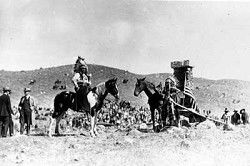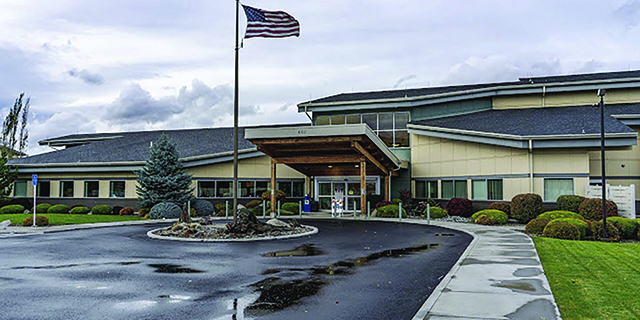Young Chief Joseph, most famous son of Wallowa County
Published 5:00 pm Thursday, May 29, 2008

- Old Chief Joseph's reburial in 1926. <i>Archive photo/Chieftain</i>
The Nez Perce leader known as young Chief Joseph is by far the most famous son of Wallowa Country. His story is a dramatic one that resonates through the past century to modern day Wallowa County.
Chief Joseph, whose real name was Heinmot Tookyalakekt (“Thunder Rolling Down the Mountains”), was born in what later became Wallowa County in 1840. He was the son of a Wallowa Nez Perce chief named Tu-eka-kas, who converted to Christianity in 1839. He received the name Joseph at his baptism, and is commonly known as Old Chief Joseph.
Trending
Old Chief Joseph supported peace with white settlers of the Northwest and signed the Treaty of 1855, under which the Nez Perce retained lands extending from the Wallowa Valley into what is now Washington and Idaho. However, when gold was discovered in 1861 on the Nez Perce reservation – though not in the Wallowas – thousands of miners invaded the region.
In 1863, the U.S. Government attempted to negotiate a new treaty with the Nez Perce to pacify white miners and settlers. In that treaty, the Nez Perce were left with a reservation in the Idaho Territory that was one-tenth the size of the 1855 lands and did not include the Wallowa country.
Old Chief Joseph, long a proponent of peace, now took a stand: he refused to sign the 1863 Treaty or move his band from his Wallowa homeland. He remained until his death in 1871, the year before the first permanent white settlers started arriving in the Wallowa Valley.
Young Joseph succeeded his father as chief of the Wallowa band, but as political leader rather than war chief. For the next several years, a stalemate existed as Joseph’s band remained in the Wallowa Valley in defiance of the 1863 Treaty.
Finally, in the spring of 1877, U.S. Army General Oliver Howard issued an ultimatum: the Wallowa Band Nez Perce would leave within 30 days or be driven out by force. Chief Joseph recognized the imbalance of military force and agreed to move. His band at this point consisted of about 400 Indians and only about 60 warriors. They headed for the Nez Perce reservation in Idaho, crossing the Snake River at what is now Dug Bar in Hells Canyon, losing many horses and cattle because of spring flooding.
In Idaho, the band joined with other non-treaty Nez Perce for a last gathering before moving to the reservation.
Trending
Sudden violence changed everything. A few young warriors staged a raid on nearby settlements in anger at the forced move, and several whites were killed. General Howard’s troops moved in to punish the bands. The combined non-treaty Nez Perce now numbered about 750, with fewer than 200 warriors.
A decision was made to flee to Montana and seek aid from the Crow tribe, a move some historians believe Joseph opposed. Joseph did not want war. Even within his own band, it was his brother Ollokot who led the warriors.
Over the following three and a half months – and over some 1,400 miles – the Nez Perce fought a defensive war against U.S. Army forces in skirmishes and battles memorialized today on the modern Nez Perce Trail, including Big Hole, Camas Meadows and Canyon Creek.
From Idaho, the bands crossed the Lolo Pass into Montana, then moved south and east into the Yellowstone country of the Crow. The Crow offered no assistance; they even served as scouts for the U.S. Army against the Nez Perce. Finally, the Nez Perce turned north, hoping to join Sioux chief Sitting Bull in Canada.
The end came Oct. 5, 1877, when Chief Joseph surrendered to Colonel Nelson Miles at what is now Bear Paw Battlefield in northern Montana – some 40 miles from the Canadian border. The Nez Perce were hungry and exhausted, and their leading warriors had been killed in the final battle, including Lean Elk, Looking Glass and Joseph’s brother, Ollokot.
Mistakenly identified as a war chief of the rebel Nez Perce, Joseph had become famous throughout the country for the heroism of the bands’ fighting retreat.
But Joseph and his people were not treated as heroes. They were forcibly moved first to eastern Kansas, then to a reservation in what is now Oklahoma. There, many of them died of disease.
Only in 1885 were Joseph and his remaining people returned to the Northwest – some to Idaho, but Joseph and others to the Colville Reservation in northern Washington.
Chief Joseph died Sept. 21, 1904, at the age of 64 on the Colville Reservation, where Young Joseph is buried. He never gave up trying to find a way to bring his band back to his beloved Wallowas, and he even traveled to Washington, D.C. in his quest.
It is his father, Old Chief Joseph, who is interred beneath the monument at the north end of Wallowa Lake. The site is now part of the Nez Perce National Historical Park and is visited by thousands who pay their respects every year.









